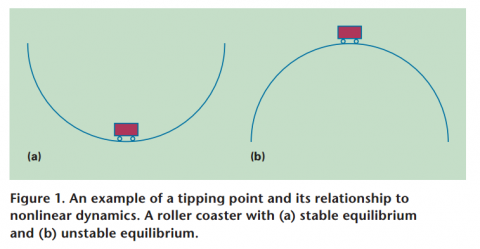Thoughts on Higher Education and Scientific Research

Jeffrey Voas, US National Institute of Standards and Technology
George F. Hurlburt, Change-Index
Keith W. Miller, University of Illinois at Springfield
Phillip A. Laplante, Penn State University
Bret Michael, Naval Postgraduate School
The notion of a “tipping point” isn’t new, although the concept has relevance in differing ways. Academia seems to be at a tipping point, whereby the steady state of disciplinary specialization is about to give way to an interdisciplinary, collaborative approach to knowledge acquisition. To understand this particular tipping point, you must first appreciate the various emergent viewpoints associated with the concept.
The Concept of a Tipping Point
Malcom Gladwell popularized the notion of tipping points in a social context in his worldwide best seller, The Tipping Point: How Little Things Can Make a Big Difference (Back Bay Book, 2002). The tipping point is frequently related to studies of complexity and chaos. Some liken the concept to a sand pile, to which adding one more grain triggers an avalanche. Others suspect similar consequence in the dynamics that trigger earthquakes or significant climate changes, albeit our knowledge is woefully lacking as to the true nature of these dynamics. Sociologists measure tipping points through observed changes in previously established social activity.
In physics, a tipping point occurs when an object is displaced from one equilibrium state into a new equilibrium state qualitatively dissimilar from the first. Complexity theory holds that tipping points frequently result from self-reinforcing, positive feedback loops. Here, a stable system selfgenerates into an unstable condition, often through amplifying oscillations. Tipping points thus reinforced can occasionally resultinchaotic behavior, leading to systemic collapse.
Tipping points are related to nonlinear dynamics. Minute differences in the initial state can result in dramatic end-state changes. As a simple example, consider two roller coaster cars at rest at different positions on the track (see Figure 1). If nudged slightly, the car in Figure 1a will soon return to rest—it’s at a stable equilibrium. However, ifthe carin Figure 1b is pushed, itwill continue in motion on a wild ride—it’s at an unstable equilibrium. In many systems, these states fluctuate as the peaks and valleys are often connected by the continuum of time.
Tipping points are difficult to describe using differential equations because the dramatic, sometimes instantaneous changes embody a discontinuity. In such situations, no one can predict an outcome by merely knowing the precise description of the initial state and a function that describes the causal structure of the systemic components. Rather, variables are treated as the sum of independent contributions, where results are both dynamic and contextually sensitive. As such, innovative tipping points will be relatively sparse in a world rooted in linear dynamics.
The term tipping point isn’t necessarily quite as pejorative as previously suggested. A tipping point can lead to new, world-changing insights. Einstein’s observations on the relationship of space, time, and the speed of light revolutionized classic physics. More recently, the discovery of long-distance relationships among subatomic particles suggests that multidimensionality and the existence of quanta are entirely reasonable propositions. Similarly, although many researchers have pursued the notion that chemicals may inhibit or halt the growth of cancer, a single researcher observed that cancer required its own vascular system to support growth and made strides in attacking the disease through inhibiting a tumor’s blood supply. Thomas Edison made many such breakthroughs ranging from the light bulb to the phonograph to motion pictures. These inventive tipping points led to disruptive changes in the way we perceive the world and interact with our environment. Thomas Kuhn calls such tipping points “paradigm shifts.”

